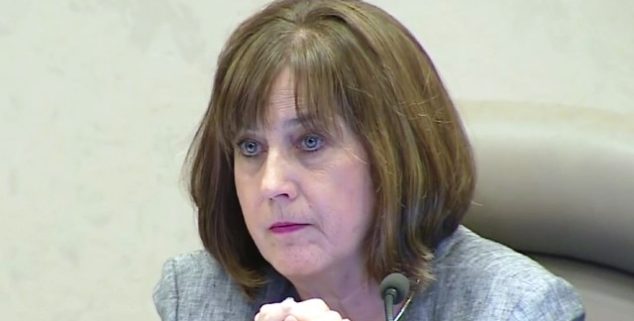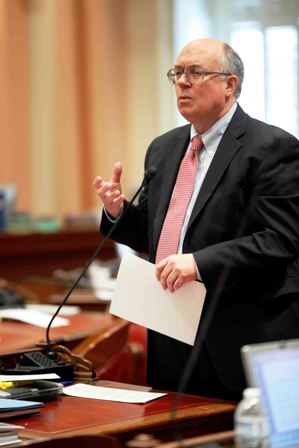News
Legacy of a young woman’s murder: Will the counties step up?
 Sacramento County Supervisor Sue Cross at a meeting of the board. (Photo: Screen capture, CBS13, Sacramento)
Sacramento County Supervisor Sue Cross at a meeting of the board. (Photo: Screen capture, CBS13, Sacramento)Editor’s Note: The death of 19-year-old Laura Wilcox, shot by a gunman with a history of psychiatric problems, inspired a 2002 California law to make it easier for families to get help for a mentally ill relative. The issue is this: Will the counties — including Sacramento and Santa Clara — agree to strengthen the original law? The deadline looms. (Second of two parts. Part I can be viewed here.)
Sue Frost, chair of the Sacramento County Board of Supervisors, did not originally support a 2002 state law that provides family members with one of the few legal avenues to get severely mentally ill relatives into intensive treatment. Like other public officials, she was concerned about patient rights and cost.
But she supports it now.
“There are people in our world who cannot take care of themselves, and they need help,” the former emergency room nurse said in a recent interview with Capitol Weekly. “You can’t exercise your civil rights if you’re seriously mentally ill or in a drug-induced psychosis.”
The original law was strengthened by legislation last year that requires counties to start such programs or publicly provide specific reasons why they are not
Faced with looming state deadlines to adopt “Laura’s Law,” California counties are scrambling to hold required public hearings and report back to the state Department of Health Services by May 2, two months before programs are set to begin July 1.
The 2002 law is named for 19-year-old Laura Wilcox, who was gunned down in 2001 in a Nevada County mental-health clinic by a deranged mental patient whose family had desperately sought treatment for him, but were rebuffed by local mental health officials. Scott Thorpe went on to kill two more people, seriously injuring three, and will likely spend the rest of his life in Napa State Hospital for the criminally insane.
The original law was strengthened by legislation last year that requires counties to start such programs or publicly provide specific reasons why they are not. Previously, counties could quietly decline to adopt Laura’s Law, which most did. Twenty California counties now have such programs and report significant success in reducing hospitalizations, incarceration and homelessness for a small subset of individuals who are resistant to treatment, at huge public and human cost.
Now widely adopted throughout the country, 46 states have Assisted Outpatient Treatment programs (AOT, or Laura’s Law in California).
Counties that fail to “opt out” of Laura’s Law will automatically be required to start AOT programs. Most of California’s larger counties now have such programs, accounting for an estimated 65-to-70 percent of the state’s population.
The two remaining major holdouts, Sacramento and Santa Clara, are each surrounded by counties with successful Laura’s Law programs. With state deadlines approaching, debate in both counties is intensifying, and advocates complain that requirements for a full airing of public comment have been stifled by county mental health officials long resistant to AOT programs.
While many legislators opposed the original law because of concerns about involuntary treatment, opposition has waned as the law demonstrated significant success
Although Santa Clara County officials appear to be well on the way to a final decision next month, Sacramento County recently requested – and was granted — an extension until the statutory deadline of July 1. The 2020 law , by then state Assemblywoman (now state Sen.) Susan Eggman, D-Stockton, was passed unanimously by the state Legislature and took effect Jan. 1, but the author gave the counties six months to prepare and implement programs – or publicly explain why they are not.

Joe Simitian, member, Santa Clara County Board of Supervisors
Two virtual public meetings of the Health and Hospital Committee of the Santa Clara County Board of Supervisors, on Feb. 17 and March 24, included intense public discussion, with considerable public comment, almost entirely in support of Laura’s Law. One of several letters to the committee was signed by San Jose City Councilman Matt Mahan and 40 other mental health, business and environmental leaders. They noted that other Bay Area counties have had “great success” with AOT, and that San Francisco reported saving more than $400,000 a month in reduced hospitalizations, incarceration and homelessness among clients receiving intensive AOT services.
Clearly dissatisfied with county behavioral health staff recommendations that the Santa Clara board “opt out” of Laura’s Law, committee chair Joe Simitian said at the Feb. 17 meeting that he was “not persuaded” by county recommendations. Both members of the Health and Hospital Committee – Simitian and Supervisor Otto Lee – strongly recommended during the March 24 meeting that the five-member Board of Supervisors adopt Laura’s Law when the full board meets on May 25.
Simitian was a state Assemblyman (and later a state Senator), who voted for Laura’s Law when it was passed in 2002. It had no funding and included a five-year “sunset” provision that has been repeatedly renewed. The law was finally made permanent in last year’s legislation.
The mental health court judges in the criminal courts are among the strongest supporters of Laura’s Law.
While many legislators opposed the original law because of concerns about involuntary treatment, opposition has waned as the law demonstrated significant success, and compliance was mostly voluntary in a civil court process that aimed to keep people out of prisons and jails ill-equipped to house, much less help, them. California jails and prisons are often described as “the new asylums” because of the large number of inmates (as many as half) who are mentally ill.
“Because we have other large counties with programs, we now have some experience,” said Simitian in an interview with Capitol Weekly, “and the experience in other counties is encouraging. It’s very clear to me that there is a need that our current programs do not address.”
Judges support ‘Laura’s Law’
Ironically, while the two county governments – mainly the Behavioral Health departments in both counties – have resisted adopting Laura’s Law, both counties operate highly regarded Mental Health Courts, which seek to divert mentally ill defendants from jail into treatment, but only after they’ve been arrested for crimes.
The mental health court judges in the criminal courts are among the strongest supporters of Laura’s Law, a civil court process designed to intervene before individuals — whose crimes are a result of their mental illness and/or “self-medicating” with illegal street drugs — become ensnared in the criminal justice system. AB 1976 also adds judges to the list of individuals who can make referrals, and creates a mechanism for several counties to collaborate on Laura’s Law programs.
“There is very little a judge is specifically able to do under the law, other than lend our black robe (often called the ‘black robe effect’) to the treatment effort.” — Lawrence Brown
In a strongly worded letter of support for AB 1976 last year, Sacramento Superior Court Judge Lawrence Brown, a former prosecutor who has long presided over Sacramento’s Mental Health Court, said the new law “will shift the burden in the debate to squarely where it belongs, namely on those seeking to prevent its implementation.”
Brown talks openly about his own family’s experiences with his schizophrenic sister. He attributes county resistance to Laura’s Law to “misunderstanding or unfounded fears,” and said Sacramento County’s “failure to enact AOT has not been for want of trying, by NAMI (the influential National Alliance on Mental Illness) and many families with loved ones suffering from serious mental illness.”
In several interviews with Capitol Weekly, Brown said a judge’s role in Laura’s Law is generally minimal, since most cases are voluntary. “There is very little a judge is specifically able to do under the law, other than lend our black robe (often called the “black robe effect”) to the treatment effort,” he said. “It gives families an opportunity to have their loved one connected to treatment, even if they are initially resistant.
“It is lost on me how anyone could be opposed to that.”
Other judges in the mental health court system strongly support AOT as another “tool” in efforts to reduce the increased incarceration of people, often for petty or drug-related crimes, whose mental illness is the root cause of their criminal behavior. “We have this huge gap,” says Santa Clara County Superior Court Judge Stephen Manley, who is frequently described as creating “the gold standard” in mental health courts. “Why should people have to commit a crime to get treatment?”
Nevada County, where Laura Wilcox was killed, became the first Laura’s Law county in California in 2008, six years after the law was passed.
County behavioral health directors point to other mental-health programs as doing the work of AOT, but Laura’s Law advocates say those programs, while important, lack the judicial component of Laura’s Law — with limited judicial intervention.
Santa Clara County has numerous, well-funded mental-health programs, which Manley praises, and regularly works with in his court. But he says Laura’s Law “provides for more intense treatment for those who cannot or will not participate in treatment, or think there isn’t really anything wrong with them.” While they are a small percentage of the mentally ill population, Manley added, “they cost society so much money – in arrests, hospitalizations.”
Nevada County, where Laura Wilcox was killed, became the first Laura’s Law county in California in 2008, six years after the law was passed. Nevada County Superior Court Judge Tom Anderson, a former public defender who represented Laura’s killer, Scott Thorpe, now presides over the county’s Mental Health Court and has actively advocated for Laura’s Law (as did his former client’s family, an unusual alliance between the families of the victim and her killer, which Anderson helped to facilitate).

Laura Wilcox in her high school yearbook. (Family photo)
“The statistics are very clear,” he said. “You save more money than you spend because AOT is effective in reducing the costs of hospitalization, which are enormous, as well as police costs, not to mention the human effects on a person’s family and neighbors.” He is blunt in his criticism of county governments that oppose Laura’s Law, attributing their reluctance to “bureaucratic stubbornness.”
“It’s mystifying that they would not adopt a program that has been proven to be very effective and saves money. What other programs can you say that about?”
Counties cite controversy, start-up costs
Dr. Ryan Quist, a psychologist who is director of the Sacramento County Behavioral Health Department, declined to be interviewed for this article, citing “the long history and complexity of this subject.”
He responded to questions instead in a lengthy email that emphasized the “passionate advocates both for and against AOT” – ostensibly pitting family members against “consumers of services” who oppose involuntary treatment (which some do, but certainly not all). “Sacramento County staff are having discussions with advocates on both sides. . .in determining how to move forward.”
Like officials in other counties, Quist also pointed to existing programs that are “as effective” as AOT in providing “intensive case management.” One program cited by Quist and other Sacramento County mental health officials is CARE-Plus (Community Alternatives for Recovery and Engagement-Plus), which is for clients who are in conservatorships, one of the most restrictive categories under Lanterman-Petris-Short, the largely unchanged 1967 law that has governed state mental health policy for decades. Conservatorships are rare, legally difficult to obtain, and generally not part of Laura’s Law programs.
“It’s constantly puzzling to me that Sacramento County is so stuck in opposition when there is so much support for the efficacy of [AOT]. It’s really disheartening.” — Carol Stanchfield
Funding is also an issue for the counties, although AOT supporters say most programs are funded through Medi-Cal and the state Mental Health Services Act, passed as Proposition 63 in 2004. “The people who this would serve already qualify for services,” says Carol Stanchfield, who has long directed Nevada County’s AOT programs, and provides training for other counties starting such programs. “There are other sources [of funding]. They can’t lean on those excuses anymore.
“It’s constantly puzzling to me that Sacramento County is so stuck in opposition when there is so much support for the efficacy of [AOT]. It’s really disheartening.”
Laura’s Law requires that county programs not reduce other services in order to start AOT programs, but county officials argue there are start-up costs for any new program. And Quist said in his email that counties may see “dramatic cuts” in MHSA funding as a result of the economic impact from the pandemic – a contention disputed by Laura’s Law supporters.
While Sacramento County behavioral health officials have not yet made a recommendation to the Board of Supervisors, Laura’s Law supporters are cautiously optimistic about the board’s ultimate action, as are supporters in Santa Clara County about the vote there.
Like many public officials with long history in the Laura’s Law debates, who originally opposed the law at the county level, Sacramento board chair Frost now supports it, and she has advocated with other board members and county officials for action to establish AOT programs in the county.
Frustrated by the county’s staff response to the new law, she wrote a strongly worded letter to Behavioral Health Director Quist on March 18, just days after two Behavioral Health department public hearings which gave short shrift to public comment and generated widespread outrage from the many advocates who had signed up to comment, ask questions.
Quist responded in a March 25 letter describing the county’s public outreach, and noted that in community responses to an online survey (172 responses by March 22), 74 percent favored opting in to an AOT program, 11 percent were opposed, and 15 percent “neutral or unsure.” He said more than 180 people registered for the March 15 and 16 hearings. Frost also requested “further public outreach” from county mental health officials, who have since scheduled another “virtual forum” on April 19 for public comment, before the issue goes to the full board.
“It is disappointing to see that these discussions have not been conducted in a way that is conducive to actual discussion,” Frost, who attended one of the virtual hearings last month, wrote in her two-page letter. “AOT was not explained, questions from the public were not addressed, the meetings were less than 30 minutes long (while being advertised for a full hour), and…were not recorded for later viewing.
“I was counting on being able to utilize these public hearings to help me come to a better understanding of AOT and my eventual position on it, but was left with nothing of value as a result. . .It is rare that a program has so much support that it receives unanimous support in the Legislature, but that is what happened with AB 1976, and I do not wish to see Sacramento County take it lightly. At this point, public perception is that we are not interested in actually considering adopting AOT. I hope that is not the case.”
—
Editor’s Note: Sigrid Bathen is a Sacramento journalist and former Sacramento Bee reporter who taught journalism at Sacramento State for 32 years. She has long covered mental-health issues, for several publications, and her writing has won numerous awards. She has covered health care, education and state government for Capitol Weekly since 2005. Her web site is www.sigridbathen.com. She can be reached at [email protected].
Want to see more stories like this? Sign up for The Roundup, the free daily newsletter about California politics from the editors of Capitol Weekly. Stay up to date on the news you need to know.
Sign up below, then look for a confirmation email in your inbox.

Leave a Reply